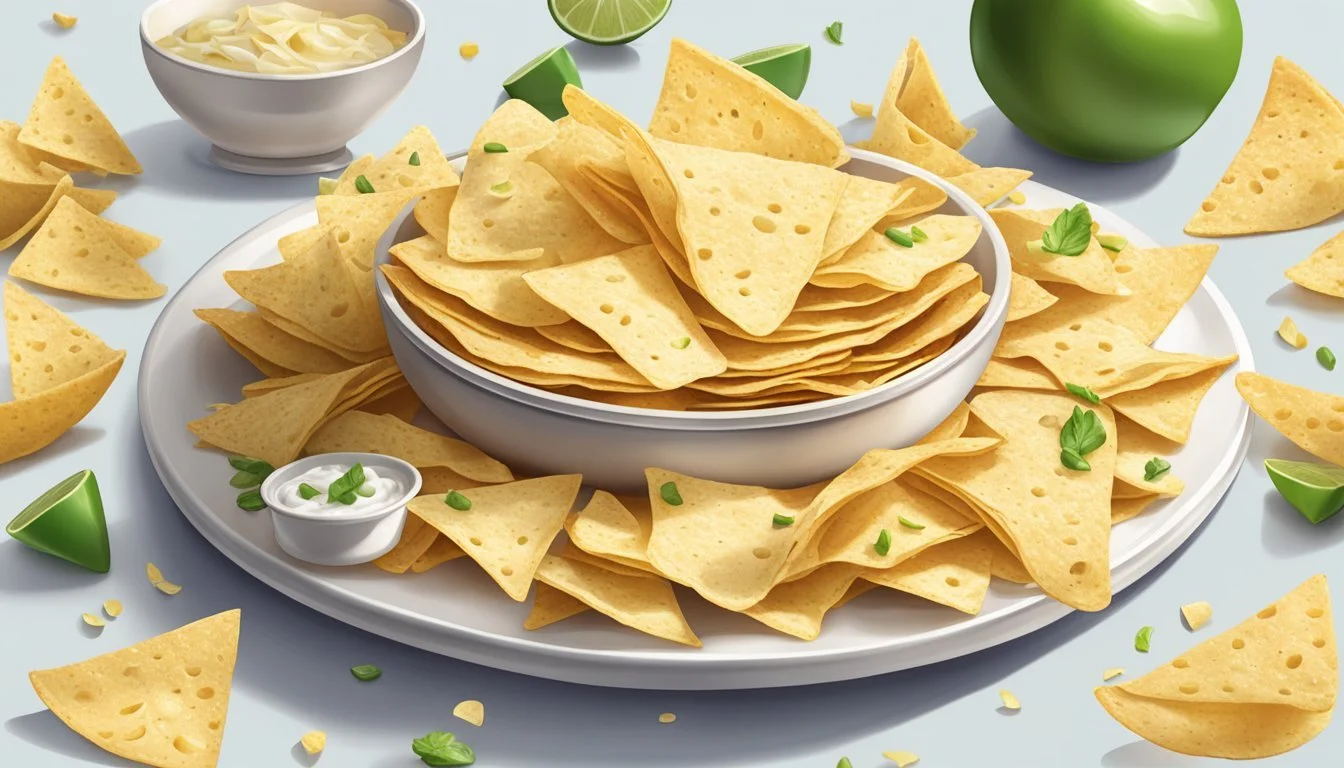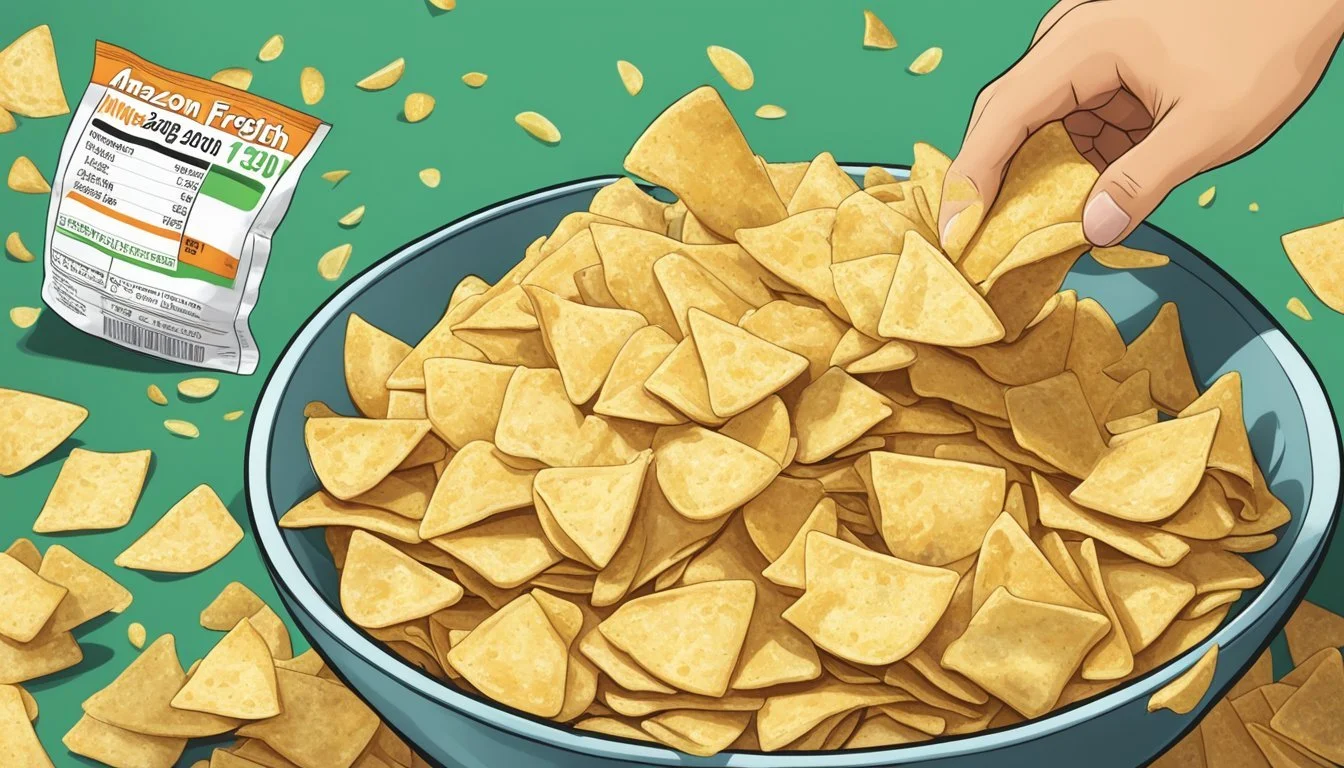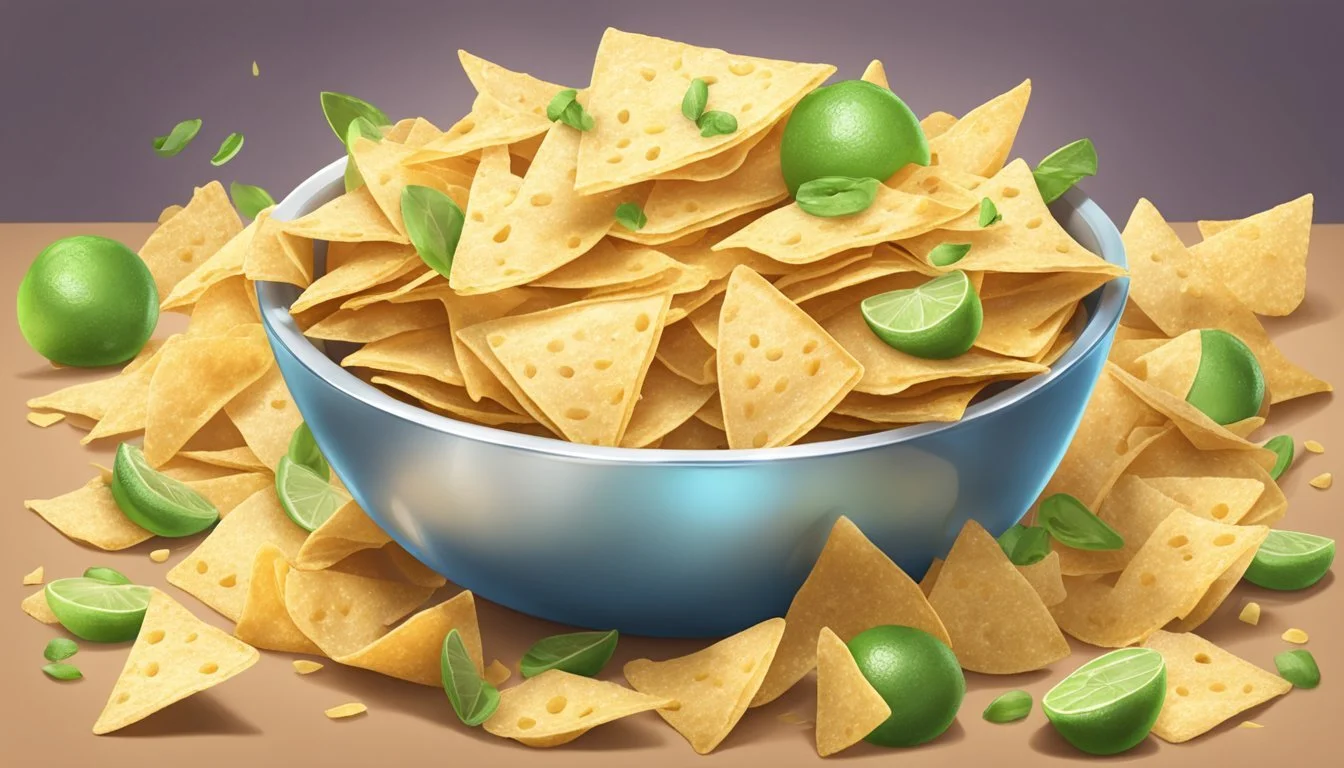How Many Servings of Amazon Fresh Tortilla Chips Is Too Much
A Balanced Guide
Amazon Fresh tortilla chips can be a delicious and convenient snack, but it's essential to consider portion sizes to maintain a healthy diet. A standard serving size is about 1 ounce, which is roughly 10-15 chips, depending on their size. Consuming more than three servings worth can lead to an unhealthy intake of calories, fat, and sodium.
It's easy to lose track of how many chips you consume, especially when enjoying them with friends or as part of a meal. This can quickly add up, pushing your intake into the range of unhealthy eating habits. While an occasional indulgence is not harmful, regularly eating excessive amounts can contribute to weight gain and other health issues.
The key is moderation. Paying attention to serving sizes and being mindful of how much you eat can help enjoy tortilla chips without compromising your health goals. Understanding what constitutes a healthy portion will allow you to snack smarter and maintain a balanced diet.
Understanding Servings and Portion Control
Comprehending the difference between serving size and portion control helps maintain a balanced diet and avoid excessive intake, especially with snack foods like tortilla chips.
Defining Servings for Tortilla Chips
A serving size for Amazon Fresh tortilla chips, as listed on the Nutrition Facts label, is typically about 1 ounce or around 28 grams. This amounts to roughly 10-15 chips, depending on chip size and brand-specific packaging. Serving size provides a standardized measure for nutritional content.
Key Serving Size Metrics:
Calories: Generally around 140-150 per serving
Carbohydrates: Typically 18-20 grams
Fat: Usually 7-8 grams
Understanding these metrics helps gauge daily intake and better manage dietary goals.
The Role of Moderation
Moderation is fundamental when consuming tortilla chips. Eating multiple servings in one sitting increases calorie intake substantially.
Example of Overconsumption:
3 servings = 420-450 calories
54-60 grams of carbohydrates
21-24 grams of fat
While tortilla chips can be part of a balanced diet, habitual overconsumption can lead to weight gain and disrupt nutritional balance. Balancing chip intake with other nutrient-rich foods such as vegetables or lean proteins promotes a more wholesome diet.
Significance of Serving Size in Nutrition
Serving sizes impact nutritional balance significantly. Knowing and adhering to serving sizes ensures consistent intake of calories, fats, and carbohydrates without excess.
Nutritional Awareness:
Appropriate serving sizes help maintain calorie control.
Portion control can prevent overeating and support weight management.
Educating oneself on standard serving sizes fosters healthier eating habits.
For tortilla chips, mindful eating practices involve measuring portions and being aware of cumulative intake throughout the day. This approach aids in enjoying snacks while maintaining a balanced diet and meeting nutritional goals effectively.
Nutritional Composition of Tortilla Chips
Tortilla chips are a popular snack, but understanding their nutritional composition is crucial. This section examines the key nutritional elements, including calories, macronutrients, important vitamins and minerals, and the presence of fats and sodium.
Calories and Macronutrients
Tortilla chips contain a mixture of calories, fats, proteins, and carbohydrates. One ounce (28 grams) of tortilla chips typically has:
Calories: 120-140 calories
Total Fat: 7-8 grams
Saturated Fat: Around 3.5 grams
Protein: 2 grams
Carbohydrates: 17-18 grams
Fiber: About 1 gram
Sugars: 0 grams
Calories from fats constitute a significant part of the snack. Protein content is relatively low, making it essential to consider these factors if consumed regularly.
Micronutrients in Tortilla Chips
Apart from macronutrients, tortilla chips also provide some essential micronutrients:
Potassium: Approximately 55.9 mg
Iron: Low, with values around 2% of the daily value (DV)
Calcium: Minor amounts, typically below 2% DV
Despite their popularity, tortilla chips offer limited vitamins and minerals. It's important to be aware of these values when integrating chips into a balanced diet.
Understanding Fats and Sodium in Chips
Fats and sodium are significant components of tortilla chips and essential to consider:
Total Fat: 7-8 grams per serving
Saturated Fat: About 3.5 grams
Trans Fat: Typically 0 grams
High saturated fat content can be a concern for heart health if consumed excessively.
Sodium: Varies widely, but generally around 3.9 mg per serving
While relatively low in sodium, some brands may have higher amounts. Monitoring sodium intake is crucial for individuals with specific health conditions.
Understanding the composition of tortilla chips helps in making informed dietary choices. Their high fat and moderate calorie content require mindful consumption.
Health Considerations and Guidelines
Understanding how many servings of Amazon Fresh tortilla chips are too much depends on several health considerations. Proper nutrition and awareness of calorie and sodium intake are critical.
Recommended Daily Value Intake
Dietary guidelines suggest that adults should limit sodium intake to less than 2,300 milligrams per day. For those with hypertension or heart disease risk, this limit drops to 1,500 milligrams. Each serving of Amazon Fresh tortilla chips contains a notable amount of sodium, so portion control is vital.
Daily fat intake should include low levels of harmful fats such as trans fat. Ideally, adults should also aim for balanced calorie consumption, ensuring they do not exceed their daily caloric needs.
Impact of Excess Calories and Sodium
Excess calorie consumption can lead to weight gain and related health issues. Each serving of Amazon Fresh tortilla chips contributes calories that need to be managed within the context of total daily intake.
High sodium levels negatively affect blood pressure and kidney function. Regularly consuming high-sodium snacks can lead to hypertension. Monitoring and limiting intake is essential to maintaining heart and kidney health.
Choosing Healthier Tortilla Chip Options
Opting for healthier tortilla chip options can minimize adverse health effects. Selecting chips with lower sodium and fat content is beneficial. Amazon Fresh offers various choices that may include reduced salt and healthier fat profiles.
Additionally, reading nutrition labels to identify products with fewer additives and preservatives helps in making better choices. In summary, moderation and informed decisions can aid in healthier snacking habits.
Preparing Homemade Tortilla Chips
Making homemade tortilla chips allows for customization in texture, flavor, and seasoning. Whether you fry, bake, or use an air fryer, each method offers unique benefits and results in delicious chips.
Traditional Frying Methods
For the crispiest chips, traditional frying is preferred. Start with corn tortillas and cut them into wedges. Heat oil in a deep pan to 350°F (175°C). Olive oil or vegetable oil works well.
Fry the tortilla wedges in small batches until golden brown, usually about 2 minutes per side. Remove with a slotted spoon and drain on paper towels. Sprinkle with salt while still warm.
Recipe Tips:
Use fresh tortillas for the best texture.
Ensure oil is hot enough to prevent sogginess.
Season immediately for optimal flavor absorption.
Baking Tortilla Chips at Home
Baking provides a healthier alternative. Preheat the oven to 350°F (175°C). Brush both sides of corn tortillas with a small amount of olive oil and cut into wedges. Arrange on a baking sheet in a single layer.
Bake for about 10-15 minutes, flipping halfway through. The chips should be crispy and lightly browned.
Recipe Tips:
Use extra thin corn tortillas for faster baking.
Space wedges apart to ensure even cooking.
Personalize with your favorite seasonings like garlic powder, paprika, or chili powder.
Innovative Cooking Techniques
For those looking to explore modern methods, microwaving or using an air fryer can be effective. For an air fryer, preheat to 350°F (175°C). Lightly coat tortilla wedges with olive oil and cook for 5-7 minutes, shaking the basket halfway through.
Microwaving involves brushing wedges with oil and microwaving on a microwave-safe plate for 1-2 minutes, checking frequently to avoid burning.
Recipe Tips:
Air frying produces a similar crunch to frying with less oil.
Microwaving is the quickest method but may require practice to perfect.
Always monitor closely to prevent overcooking.
Ingredient List
Corn tortillas
Olive oil (or vegetable oil)
Salt
Optional: garlic powder, paprika, chili powder
By following these guidelines, homemade tortilla chips can be tailored to your preference, offering a range of textures and flavors.
Serving and Storage Suggestions
When it comes to enjoying Amazon Fresh tortilla chips, the ways to serve them are as diverse as the occasions for storage are important. Here are some tips on how to creatively serve these chips and store them for ultimate freshness.
Creative Serving Ideas
Tortilla chips are a versatile snack. They pair well with dips like guacamole, salsa, and assorted nacho creations.
For an appetizing start to a meal, use them as the base for loaded nachos. Simply layer chips with cheese, jalapeños, beans, and baked chicken, then bake until the cheese is melted.
They also make for a great appetizer when served with pico de gallo.
For parties, consider setting up a dips bar with various salsas, guacamoles, and creamy dips.
Beyond dipping, crushed tortilla chips add a delightful crunch to salads and soups. Sprinkle them over a mixed green salad or a bowl of hearty chili for added texture.
For a sweet twist, try topping them with melted chocolate and a sprinkle of sea salt.
Proper Storage for Freshness
To keep tortilla chips fresh, storing them correctly is essential. Use an airtight container to prevent them from going stale.
If you opened a bag and didn't finish it, transfer the remaining chips to a sealed container. This keeps air out and maintains their crispiness.
For longer storage, consider freezing. Place chips in a resealable bag, label it with the storage date, and freeze. They can last up to 2-3 months in the freezer, though it is best to consume them within two months.
When stored properly, chips retain their texture and are always ready for your next party or snack session.
Potential Allergens and Dietary Restrictions
Selecting tortilla chips requires considering potential allergens and dietary restrictions. For Amazon Fresh tortilla chips, awareness of gluten and ingredient simplicity is key.
Navigating Gluten-Free Options
Amazon Fresh offers a variety of tortilla chips, some of which are gluten-free. It's vital to check labels for gluten-containing ingredients like wheat.
Gluten-free options typically use corn, salt, and oil. These ingredients are simple and less likely to cause allergic reactions. Confirm on packaging that the product is certified gluten-free to avoid cross-contamination.
Opt for chips with minimal ingredients. This ensures a versatile snack that fits many dietary needs.
Dietary restrictions can vary, so always read ingredient lists carefully. Awareness and diligence help ensure a safe and enjoyable snacking experience.
Seasonings and Flavor Variations
Choosing the right seasonings can elevate Amazon Fresh tortilla chips from a simple snack to a culinary delight. Whether making your own mix or opting for store-bought flavors, the possibilities are endless.
Homemade Seasoning Mixes
Creating your own seasoning mix allows for customization to match personal tastes. A popular choice is a blend of olive oil, sea salt, and lime juice. This combination offers a fresh and tangy flavor.
For those who prefer a bit of heat, a mix of cumin, paprika, and chipotle chili powder can add smokiness and spice. An even more adventurous option involves Tajin, known for its unique zing from lime juice and chili peppers.
Using kosher salt instead of regular table salt can provide a cleaner, less metallic taste. This is particularly effective when combined with other robust spices.
Popular Store-Bought Flavors
There are several convenient, pre-made seasonings available for those who prefer to skip the DIY route. Classic options include sea salt and lime. These flavors are mild but offer a refreshing citrus twist to the chips.
Cheese lovers might enjoy varieties such as nacho cheese or parmesan garlic. Both provide a rich, savory experience.
For something spicier, chili lime is a favorite, blending the heat of chili peppers with the tang of lime for a well-balanced kick.
Many brands also offer ranch-flavored tortilla chips, combining herbs like dill with a creamy base seasoning for a comforting snack.
Choosing the right seasoning, whether homemade or store-bought, adds a special touch to tortilla chips, enhancing their inherent flavors and making each bite more enjoyable.









